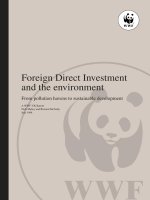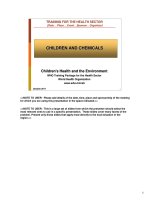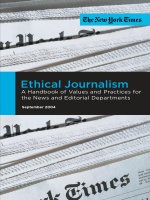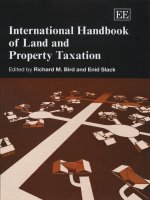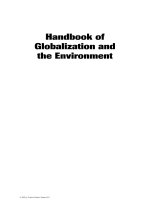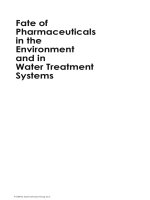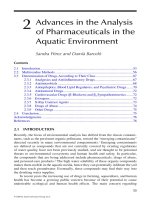Handbook of Globalization and the Environment doc
Bạn đang xem bản rút gọn của tài liệu. Xem và tải ngay bản đầy đủ của tài liệu tại đây (4.69 MB, 602 trang )
q 2007 by Taylor & Francis Group, LLC
q 2007 by Taylor & Francis Group, LLC
q 2007 by Taylor & Francis Group, LLC
q 2007 by Taylor & Francis Group, LLC
q 2007 by Taylor & Francis Group, LLC
q 2007 by Taylor & Francis Group, LLC
q 2007 by Taylor & Francis Group, LLC
Preface
In the past few decades, worldwide social, political, legal, ethical, cultural
and technological forces have led to a globalization movement. Indeed, many
efforts have been made in globalizing various economic areas, including global
environmental protection, world trade agreements, global sustainable develop-
ment, etc. However, there are many debates on globalization and its effects on
the environment and/or sustainable economic growth around the globe. Some
argue that globalization protects the global environment from environmental
degradation and promotes sustainable economic growth in the world, especially
in developing countries. But some others, particularly those in developing
countries, believe that globalization is a threat to economic growth and sustain-
able development. This handbook will address these major issues: globalization,
development, and the environment. We hope that the book will enrich this
debate.
Khi V. Thai
Dianne Rahm
Jerrell D. Coggburn
q 2007 by Taylor & Francis Group, LLC
The Editors
Khi V. Thai, PhD, is professor of public administration at the Florida Atlantic
University (FAU) in Fort Lauderdale, Florida. Currently, he serves as director
of the Public Procurement Research Center, created under a partnership
agreement between FAU and the National Institute of Governmental
Purchasing, Inc. His research interests are in public finance management,
health care, and public procurement. He has authored or co-authored, and
edited or co-edited over 80 refereed articles, book chapters and technical
reports, journal symposia, and nine books including Introduction to Public
Procurement (2004), Developing and Managing Requests for Proposals in the
Public Sector (2004), Advancing Public Procurement: Practices, Innovation
and Knowledge Sharing (co-editor) (2006), Public Budgeting: A Managerial
Perspective (co-author) (Forthcoming), and Handbook of Public Procurement
(Editor) (forthcoming). He is also an editor, Journal of Public Budgeting,
Accounting & Financial Management, editor-in-chief, Journal of Public
Procurement, and managing editor, International Journal of Organization
Theory and Behavior. He has organized a variety of training programs and
study tours, including the advanced leadership and management program for
high-ranking government officials from third world countries. He also has
provided consulting services in public procurement (including, most recently,
Sierra Leone’s procurement reform, Canada’s federal government procurement
review, and Uganda’s procurement transparency).
Dianne Rahm, PhD, is professor of public administration at The University
of Texas at San Antonio. Dr. Rahm received her PhD from the Syracuse
University’s Maxwell School of Citizenship and Public Affairs. Her research
interests are in environmental policy, energy policy, and science and technology
policy. She has authored or co-authored, and edited or co-edited over 50 articles,
book chapters, and reports and five books including Sustainable Energy and the
States: Politics, Markets, and Leadership, (2006), United States Public Policy:
A Budgetary Approach (2004), Toxic Waste and Environmental Policy in the
q 2007 by Taylor & Francis Group, LLC
21
st
Century United States, (2002), University-Industry R&D Collaboration in
the United States, the United Kingdom, and Japan (2000), and Technology and
U.S. Competitiveness: An Institutional Focus, (1992).
Jerrell D. Coggburn, PhD, is an associate professor in the Department of
Public Administration at The University of Texas at San Antonio, where he also
serves as chair. His primary research interests are in human resources manage-
ment, public management, and public procurement. He is a past recipient (with
Sandra K. Schneider and William G. Jacoby, 1997) of the William and Frederick
Mosher Award for the best Public Administration Review article written by an
academician. Coggburn serves on the editorial board of the Review of Public
Personnel Administration and the executive board of the American Society
for Public Administration’s Section on Personnel Administration and Labor
Relations. His research has appeared in Public Administration Review, Review
of Public Personnel Administration, Journal of Public Administration Research
and Theory, Public Performance & Management Review, International Journal
of Public Administration, Public Administration Quarterly, and other scholarly
outlets. Coggburn received the BA degree (1992) in political science from
Oklahoma State University and MPA (1994) and PhD (1999) degrees from the
University of South Carolina.
q 2007 by Taylor & Francis Group, LLC
Contributors
Steffan Bauer
German Development Institute (DIE)
Bonn, Germany
Kathi K. Beratan
Duke University
Durham, North Carolina
Frank Biermann
Nicholas School of the Environment
and Earth Sciences Levine Science
Research Center
Environmental Policy Analysis
Vrije University
Amsterdam, The Netherlands
R. Michael Bireley
Department of Public Administration
The University of Texas
San Antonio, Texas
Bruce Bjork
Department of Public Administration
The University of Texas
San Antonio, Texas
Jerrell D. Coggburn
Department of Public Administration
The University of Texas
San Antonio, Texas
David Howard Davis
Political Science and Public
Administration
University of Toledo
Toledo, Ohio
Ilhom Esanov
Tashkent Institute for Irrigation
and Melioration
Tashkent, Republic of Uzbekistan
Kyle Farmbry
School of Public Affairs and
Administration
Rutgers University
Newark, New Jersey
Michael J. Gaffney
Institute for Environmental Studies
Vrije University
Amsterdam, The Netherlands
Joyeeta Gupta
Institute for Environmental Studies
Vrije University
Amsterdam, The Netherlands
Jennifer E. Horan
Department of Political Science
University of North Carolina
Wilmington, North Carolina
q 2007 by Taylor & Francis Group, LLC
Catherine Horiuchi
College of Professional Studies
University of San Francisco
San Francisco, California
Wendy A. Kellogg
Levin College of Urban Affairs
Cleveland State University
Cleveland, Ohio
Madina Khalmirzaeva
Tashkent Institute for Irrigation
and Melioration
Tashkent, Republic of Uzbekistan
W. Henry Lambright
The Maxwell School of Citizenship
and Public Affairs
Syracuse University
Syracuse, New York
Nicholas P. Lovrich
Division of Governmental Studies
and Services
Washington State University
Pullman, Washington
Donna L. Lybecker
Department of Political Science
and Environmental Studies
Pennsylvania State University
Altoona, Pennsylvania
Tetyana Lysak
Department of Political Science
Washington State University
Pullman, Washington
Aroon Manorahan
School of Public Affairs and
Administration
Rutgers University
Newark, New Jersey
Erica M. Matheny
Levin College of Urban Affairs
Cleveland State University
Cleveland, Ohio
Dayna R. Matthews
School of Urban Studies and
Public Administration
Old Dominion University
Norfolk, Virginia
Michael J. Mortimer
Department of Forestry
Virginia Polytechnic Institute
and State University
Blacksburg, Virginia
Celeste Murphy-Greene
School of Urban Studies and
Public Administration
Old Dominion University
Norfolk, Virginia
Lisa Nelson
Department of Political Science
California State Polytechnic
University
Pomona, California
Anna Ya Ni
Center for Technology and
Information Policy
The Maxwell School of Citizenship
and Public Affairs
Syracuse University
Syracuse, New York
Brian Pangrle
Lee & Hays, PLLC
Spokane, Washington
Laura E. Pasquale
Florida Department of Environmental
Protection
Tallahassee, Florida
Ross Prizzia
Public Administration
University of Hawaii, West Oahu
Pearl City, Hawaii
Dianne Rahm
Department of Public Administration
The University of Texas
San Antonio, Texas
q 2007 by Taylor & Francis Group, LLC
Kristi L. Ross
Political Science Department
Geology Department
Northern Arizona University
Flagstaff, Arizona
Zachary A. Smith
Northern Arizona University
Flagstaff, Arizona
Brent S. Steel
Department of Political Science
Oregon State University
Corvallis, Oregon
Mark Stephan
Department of Political Science
Washington State University
Pullman, Washington
Katrina Darlene Taylor
Department of Political Science
Florida Atlantic University
Fort Lauderdale, Florida
Khi V. Thai
Florida Atlantic University
Fort Lauderdale, Florida
Dang Tran
Department of Economics &
Statistics
California State University
Los Angeles, California
Rebecca L. Warner
Department of Sociology
Oregon State University
Corvallis, Oregon
Edward P. Weber
Department of Political Science
Washington State University
Pullman, Washington
Fariborz Zelli
Tyndall Centre for Climate
Change Research
Coordinator MOSAIC Research
Group
University of East Anglia
Norwich, United Kingdom
q 2007 by Taylor & Francis Group, LLC
Table of Contents
1 Globalization and the Environment: an Introduction 1
Khi V. Thai, Dianne Rahm, and Jerrell D. Coggburn
1.1: Overview 1
1.1.1: The Conceptual Meaning of Globalization 2
1.1.2: Perspectives on Sustainable Economic Growth 2
1.1.3: Globalization, the Environment, and Sustainable Economic Growth 2
1.1.3.1: Globalization and Sustainable Economic Growth 3
1.1.3.2: Globalization and a Sustainable Environment 4
1.2: Book Contents 5
1.2.1: Part One: Global Environmental Issues and Policies 5
1.2.2: Part Two: Global Environmental Organizations and Institutions 8
1.2.3: Part Three: Environmental Management and Accountability 10
1.2.4: Part Four: Controversies in Globalization and the Environment 12
Acknowledgments 14
References 14
PART I: GLOBAL ENVIRONMENTAL ISSUES AND POLICIES
2
Sustainable Development in an International
Perspective 19
Ross Prizzia
2.1: The Movement toward Sustainable Development 19
2.1.1: Definition 19
2.1.2: From Stockholm to Rio, Kyoto, and Beyond 20
2.1.3: Growth as a Challenge to Sustainable Development 22
2.1.4: Sustainable Development in the United States 26
2.2: National Strategies and Good Practices
in OECD Countries 28
2.2.1: Policy Integration 30
2.2.2: Intergenerational Timeframe 31
2.2.3: Analysis and Assessments 32
2.2.4: Indicators and Targets 33
q 2007 by Taylor & Francis Group, LLC
2.2.5: Coordination and Institutions 34
2.2.6: Local and Regional Governance 35
2.2.7: Stakeholder Participation 36
2.2.8: Monitoring and Evaluation 37
2.3: Conclusion 39
References 40
3 European Global Warming Policy 43
David Howard Davis
3.1: Introduction 43
3.2: The European Union Commission 43
3.3: Climate Change Treaty Structure 47
3.4: EU Involvement 48
3.5: The Kyoto Conference 50
3.6: Trading 53
3.7: The Individual European Countries 55
3.8: Conclusion 60
References 60
4 Transborder Air Pollution 61
Zachary A. Smith and Katrina Darlene Taylor
4.1: Introduction 61
4.2: Air Pollution 62
4.2.1: Causes 62
4.2.2: Acid Deposition 63
4.3: Countries Significantly Affected by Transborder
Air Pollution 63
4.3.1: Europe 63
4.3.2: Russia 64
4.3.3: United States and Canada 64
4.3.4: United States and Mexico 65
4.3.5: China and Japan 65
4.4: The Globalization Effect 65
4.4.1: WTO 66
4.4.2: NAFTA 66
4.4.3: Viewpoints of the Relationship between Trade
Liberalization and the Environment 66
4.5: International Environmental Regimes 67
4.5.1: Trail Smelter Dispute 68
4.5.2: LRTAP 69
4.5.3: MOI 71
4.5.4: La Paz 72
4.6: Conclusion: Future Trends in Transborder Air Pollution Control 72
References 75
5 Desertification 77
Steffan Bauer
5.1: Introduction 77
5.2: Desertification as a Global Issue 78
q 2007 by Taylor & Francis Group, LLC
5.2.1: The Issue at Stake: Dryland Degradation 78
5.2.2: A Brief History of Desertification 81
5.2.3: Desertification and Global Interdependence 82
5.2.3.1: Agricultural Trade Liberalization 83
5.2.3.2: Climate Change and Loss of Biological Diversity 84
5.3: Governing Global Desertification 85
5.3.1: The Political Globalization of Desertification 85
5.3.2: The UNCCD Process in its First Decade 87
5.4: Summary and Outlook 90
References 91
6 The Environmental Frontier of Space 95
W. Henry Lambright and Anna Ya Ni
6.1: Introduction 95
6.2: Conceptual Framework 96
6.3: Space and the Home Planet 96
6.3.1: Space in the Environment—Energy Decade 97
6.3.2: The Ozone Hole 99
6.3.3: Mission to Planet Earth and Earth Observation System 99
6.3.4: Landsat 100
6.4: Near-Earth Orbit 102
6.4.1: The Commercial Significance of Geosynchronous Orbit 102
6.4.2: Policy Problems of Geosynchronous/
Geostationary Orbit 104
6.4.3: Electromagnetic Spectrum 105
6.4.4: The Role of International Telecommunications Union 106
6.4.5: Space Debris 106
6.4.6: The Outer Space Treaty 107
6.5: Deep Space as Environment 108
6.5.1: The Moon 108
6.5.2: Mars 109
6.5.3: Beyond 110
6.6: Conclusion 111
References 112
7 Human Rights to Water 115
Zachary A. Smith and Kristi L. Ross
7.1: Introduction 115
7.2: Addressing the Variables that Affect Access 116
7.2.1: Distribution, Supply, and Demand 116
7.2.2: Pollution 118
7.3: Toward Human Rights to Water 119
7.3.1: Integrated Water Resources Management 120
7.3.2: What is a Human Right to Water? 121
7.3.3: Challenges 123
7.3.4: International Trade 125
7.4: Implications of a Human Right to Water 126
7.5: Alternatives 129
7.6: Conclusions 130
References 132
q 2007 by Taylor & Francis Group, LLC
PART II: GLOBAL ENVIRONMENTAL ORGANIZATIONS AND
INSTITUTIONS
8
Global Environmental Governance 137
Frank Biermann
8.1: Introduction 137
8.2: The Concept of Global Environmental Governance 138
8.3: Characteristics of Global Environmental Governance 141
8.3.1: Increased Segmentation: Complexity through
Fragmentation 141
8.3.2: Increased Participation: Diversity through Inclusion 142
8.3.3: Increased Privatization: Negotiation through Partnerships 144
8.4: Current Reform Debates 144
8.4.1: Segmentation: the Debate on a United Nations Environment
Organization 145
8.4.2: Participation and Privatization: Institutionalizing
Civil Society Involvement 148
8.5: Conclusion 149
References 150
9 The Role of the United Nations: from Stockholm
to Johannesburg 155
Lisa Nelson
9.1: Introduction 155
9.2: Stockholm, 1972: Convention on the Human Environment 158
9.2.1: Creation of the UNEP 158
9.2.2: Initial Multilateral Environmental Agreements, 1972–1987 159
9.3: Brundtland Report, 1987 160
9.4: Rio De Janeiro, 1992: the Earth Summit and Agenda 21 161
9.4.1: The Rio Declaration 161
9.4.2: Agenda 21 161
9.4.3: The Convention on Climate Change 162
9.4.4: The Convention on Biodiversity 162
9.4.5: Commission on Sustainable Development 162
9.4.6: Rio C5 163
9.4.7: Summary of Rio Conference 163
9.5: The Millennium Development Goals, 2000 163
9.6: Johannesburg, 2002: Renewal of Commitments 166
9.7: Additional Conventions and Secretariats, 1993–2002 166
9.8: Beyond the 2002 Earth Summit 167
Appendix A: Rio Declaration 170
Annex I 170
Appendix B: Excerpt from the Johannesburg Declaration on
Sustainable Development 174
References 174
10 The World Trade Organization: Free Trade and Its
Environmental Impacts 177
Fariborz Zelli
10.1: Introduction 177
10.2: What Impact and How to Assess It? 178
q 2007 by Taylor & Francis Group, LLC
10.2.1: Classical Assumptions about the Impact of
Trade Liberalization 178
10.2.2: Looking for a Signpost: the WTO’s Effect on Domestic
and International Environmental Policies and Standards 180
10.3: The WTO’s Environmentally Relevant Institutions 182
10.3.1: The Old GATT and the Environment 183
10.3.2: WTO Bodies of Environmental Relevance 184
10.3.3: WTO Rules of Environmental Relevance 185
10.4: Conflicts between WTO Law and Domestic Environmental Law 187
10.4.1: Cases on Issues of Species Protection and Biological Diversity:
Direct Import Restrictions 188
10.4.2: Cases on Human Health Issues: Risk Assessment, Prior Informed
Consent, and Labeling Requirements 190
10.4.3: Conclusion: the WTO is Taking Over 192
10.5: Conflicts between WTO Law and Multilateral Environmental
Agreements 193
10.5.1: Increasing Institutional Overlap and Conflict among
International Institutions 193
10.5.2: The Basel Convention, Cites and the Montreal Protocol:
Direct Import Restrictions 194
10.5.3: The Climate Change Regime: Mix of Direct and
Indirect Trade Restrictions 196
10.5.4: The Convention on Biological Diversity: Benefit-Sharing,
Prior Informed Consent and Labeling Requirements 198
10.5.5: Conclusion: No Dispute, No Problem? 201
10.6: Strategies and Proposals to Improve WTO Compatibility with
Environmental Law 203
10.6.1: A Solution under the Legal Status Quo? 203
10.6.2: Initiatives from the Inside 204
10.6.3: Suggestions from the Outside 206
10.7: Summary and Concluding Remarks 209
References 212
11 United Nations Conferences and the Legitimization
of Environmental NGOs 217
Kyle Farmbry and Aroon Manorahan
11.1: Introduction 217
11.2: Conceptualizing NGO Growth 218
11.3: NGOs and Environment Discourse: between
Stockholm and Johannesburg 220
11.3.1: Stockholm (1972) 221
11.3.2: Implications for NGOs 222
11.4: United Nations Conference on Environment and Development,
Rio de Janeiro, 1992 223
11.5: Implications for NGOs 225
11.6: Summit on Sustainable Development, Johannesburg, 2002 226
11.7: Implications for NGOs 228
11.8: Prescriptive Thoughts 228
11.9: Conclusion 230
References 231
q 2007 by Taylor & Francis Group, LLC
12 Global Academia: the State of Environmental Learning
and Awareness 233
Brent S. Steel and Rebecca L. Warner
12.1: Introduction 233
12.2: Why is Environmental Learning Important? 235
12.2.1: Correlates and Sources of Environmental
Knowledge and Awareness 237
12.2.1.1: Information Sources 238
12.2.1.2: Formal Environmental Education 240
12.3: State of Global Environmental Awareness 240
12.4: Approaches to Increasing Environmental Awareness 244
12.4.1: Developing Countries 245
12.4.2: Postcommunist Countries 247
12.4.3: Postindustrial Countries 248
12.5: Conclusion 250
References 251
PART III: ENVIRONMENTAL MANAGEMENT AND
ACCOUNTABILITY
13
Government Green Procurement in the U.S.: an Approach
to Meeting Global Environmental Challenges 259
Jerrell D. Coggburn and Dianne Rahm
13.1: Introduction: Global Environmental Challenges 259
13.2: The U.S. Environmental Framework 260
13.3: What is “Green” Procurement? 261
13.4: Evolution of Green Procurement in Federal Government 262
13.5: Green Procurement in U.S. State and Local Governments 268
13.6: Adopting and Implementing Green Procurement 270
13.6.1: Green Procurement Policies: Mandatory versus Voluntary 270
13.6.2: Integrating Green Procurement 271
13.6.3: Strategies for Green Procurement Implementation 272
13.6.3.1: Price Preferences 273
13.6.3.2: Green Specifications 273
13.6.3.3: “Best Value” Approach and Life Cycle Analysis 274
13.6.3.4: Setting Green Procurement Goals 275
13.6.3.5: Raising Awareness about Green Procurement 275
13.6.3.6: “Green Teams” 276
13.6.3.7: Cooperative Green Procurement Efforts 277
13.7: Challenges Facing Green Procurement 277
13.8: Conclusion: Assessing Government’s Green Procurement Efforts 281
References 286
14 Environmental Management 289
Laura E. Pasquale
14.1: Introduction 289
14.2: U.S. Environmental Regulation 289
14.2.1: Introduction 289
14.2.1.1: Legislative History 290
14.2.1.2: Pollution Prevention 291
14.2.1.3: Current Regulatory Options 291
q 2007 by Taylor & Francis Group, LLC
14.2.2: Systems Analysis 292
14.2.2.1: System Characteristics and Policy Implications 292
14.2.2.2: Context 293
14.3: Environmental Management Systems 297
14.3.1: Background 297
14.3.2: Systems Analysis 299
14.3.2.1: Better Alignment 299
14.3.2.2: Decreased Resistance 299
14.3.2.3: Enhanced Use of Information 300
14.3.2.4: Increased Range of Response 300
14.3.2.5: Stronger Foundation 300
14.3.2.6: Tighter Feedback Loops 300
14.3.3: Research Data 301
14.3.3.1: Systems Research 301
14.3.3.2: Stakeholder Participation 301
14.3.3.3: Future Research 303
References 304
15 Sustainable Waterfront Development in the Great
Lakes Basin 311
Wendy A. Kellogg and Erica M. Matheny
15.1: Introduction 311
15.2: Waterfront Growth, Decline and Redevelopment in
the Great Lakes Basin 313
15.3: Urban Sustainability as a Framework for Waterfront Regeneration 316
15.4: Case Studies 317
15.4.1: Selection of Cases 317
15.4.2: Waterfront Redevelopment Cases 318
15.4.2.1: Toronto, Ontario, Canada 318
15.4.2.2: Chicago–Calumet, Illinois, United States 320
15.4.2.3: Hamilton, Ontario, Canada 322
15.4.2.4: Cleveland, Ohio, United States 325
15.5: Discussion 328
15.5.1: Shared Historic Experiences 328
15.5.2: Land 329
15.5.3: Political System 329
15.5.4: The Timeframe of Planning 330
15.5.5: Sustainability as a Waterfront Planning Framework 330
Acknowledgments 331
References 331
16 Getting Agricultural Productivity and Environmental
Sustainability at the Same Time: What Matters,
What Doesn’t? 335
Edward P. Weber, Madina Khalmirzaeva, Mark Stephan,
Tetyana Lysak, and Ilhom Esanov
16.1: Introduction 335
16.2: Research Methods 337
16.3: Performance Outcomes 338
16.4: Explaining the Policy Performance of the Uzbek WUAs 343
16.4.1: Formal Institutions: form and Function 343
16.4.2: The Physical Wealth Framework 346
q 2007 by Taylor & Francis Group, LLC
16.4.3: Informal Institutions: the Social Side of the Street 347
16.4.4: The Three Frameworks and the Policy Results:
How Do They Measure Up? 350
16.5: Conclusion 351
Appendix A: Crop Productivity Data 353
Appendix B: Participation and Awareness Index 354
Appendix C: Levels and Sources of Outside Help 354
WUA, Outside Support Crosstabulation Results 355
Appendix D: Egalitarian and Accountability Indexes 355
Egalitarian Decision-Making Index 355
Accountability Index 356
Acknowledgments 356
References 356
17 Sustainability Issues in Public Procurement 359
Brian Pangrle
17.1: Introduction 359
17.1.1: Government Spending 359
17.1.2: Sustainable or Green Procurement? 359
17.1.3: Implementation through a Procurement Code 360
17.2: Brief Background 361
17.3: What is “Sustainable”? 361
17.3.1: Experience of U.S. Forest Service 361
17.3.2: Sustainability at Various Levels 363
17.3.3: Summary of Programs 365
17.4: Implementation in the U.S.: National and Local 366
17.4.1: U.N. to National Level 367
17.4.1.1: U.N. to U.K. and Concerning EU 367
17.4.1.2: U.S. Involvement in the U.N.: Millennium
Challenge Account 367
17.4.2: U.S. National Level to Local Level 368
17.5: Objective Definitions for “Sustainable” in a
Procurement Code 369
17.5.1: Example: the Mirrae Chain and Aluminum 369
17.5.2: Example: Sustainable Buildings 371
17.6: Harmonization of Procurement Codes and
Sustainable Codes 372
17.7: Conclusion 376
References 377
18 Managing Nuclear Waste 381
Catherine Horiuchi
18.1: Introduction 381
18.2: How is Nuclear Waste Categorized? 382
18.3: Distinguishing Attributes of Nuclear Material 385
18.4: The Regulatory Framework 386
18.5: Yucca Mountain 387
18.6: Policy Modifications Resulting from the “Global War on Terror” 391
18.7: Effect of the Kyoto Protocol 392
18.8: Conclusion 393
Appendix A: Warnings across Millennia 394
Appendix B 396
References 396
q 2007 by Taylor & Francis Group, LLC
19 Inter-Agency Collaborative Approaches to Endangered
Species Act Compliance and Salmon Recovery in the
Pacific Northwest 401
Nicholas P. Lovrich, Edward P. Weber, Michael J. Gaffney, R. Michael Bireley,
Bruce Bjork, and Dayna R. Matthews
19.1: Introduction 401
19.2: Legal and Physical Setting 403
19.2.1: Background 403
19.2.2: The NOAA Response 404
19.2.3: The WDFW Response 405
19.2.4: Strategy for Implementation 406
19.3: The Methow Valley 407
19.3.1: Background 407
19.3.2: Okanogan County Memorandum of Understanding 409
19.3.3: Compliance in the Methow Valley 409
19.3.4: MOU Negotiations Fail 410
19.4: The Walla Walla River Basin 410
19.4.1: Background 410
19.4.2: A Take Occurs in the Walla Walla Basin 410
19.4.3: Compliance Issues in the Walla Walla River Basin 411
19.4.4: The Environmental Advocacy Component 412
19.4.5: Compliance in the Walla Walla Basin-Cooperation
Rather than Confrontation 413
19.4.6: The Cooperative Compliance Initiative 413
19.4.7: Interim Outcomes in the Walla Walla 414
19.5: Methods 415
19.5.1: Defining Success 415
19.5.2: The Need to Measure Outcomes 415
19.6: Findings 417
19.6.1: Demographic Factors 417
19.6.2: Environmental and Political Values 418
19.6.3: Level of Trust in Key Actors 422
19.6.4: Support for the ESA 423
19.6.5: Citizen Perceptions of Good Faith Bargaining 424
19.7: Discussion 425
19.8: Conclusion 426
References 427
PART IV: CONTROVERSIES IN GLOBALIZATION AND THE
ENVIRONMENT
20
Eco-Terrorism: a Natural Reaction to Violence? 433
Michael J. Mortimer
20.1: Introduction to a Cause 433
20.2: Definitions, Semantics, and a Common Syntax 435
20.3: Direct Action in a Contemporary Context 438
20.4: Causal Factors: Self-Defense, Environmental Preservation,
and Anti-Global Rhetoric 439
20.5: Defining Anti-Globalism 441
20.6: Implications for the Future 442
q 2007 by Taylor & Francis Group, LLC
